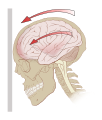JAMA: Among children and adolescents who experienced a concussion, physical
activity within 7 days of injury compared with no physical activity was
associated with reduced risk of persistent postconcussive symptoms at
28 days, according to a study appearing in the December 20 issue of JAMA. Rest has long been considered the cornerstone of concussion
management, and pediatric guidelines universally recommend an initial
period of physical rest following a concussion until symptoms have
resolved. No clear evidence has determined that avoiding physical
activity expedites recovery. Roger Zemek, M.D., of Children’s Hospital
of Eastern Ontario Research Institute, Ottawa, Canada, and colleagues
conducted a study that included 3,063 children and adolescents with
acute concussion from 9 Pediatric Emergency Research Canada network
emergency departments.
Physical activity participation and
postconcussive symptom severity were rated using standardized
questionnaires in the emergency department and at days 7 and 28
postinjury. Persistent postconcussive symptoms (PPCS) were assessed at
28 days postenrollment.
The final study group included 2,413 participants, of whom PPCS at 28
days occurred in 733 (30 percent); 1,677 (70 percent) participated in
physical activity within 7 days, primarily with light aerobic exercise.
Of the patients who engaged in early physical activity, 31 percent were
symptom free and 48 percent had at least 3 persistent or worsening
postconcussive symptoms at day 7. Of those reporting engaging in no
physical activity at day 7, 80 percent had at least 3 persistent or
worsening postconcussive symptoms at day 7. Resumption of physical
activity within 7 days postconcussion was associated with a lower risk
of PPCS as compared with no physical activity. This finding was
consistent across analytic approaches and intensity of exercise.
“Early physical activity could mitigate the undesired effects of
physical and mental deconditioning associated with prolonged rest.
Regardless of potential benefit, caution in the immediate postinjury
period is prudent; participation in activities that might introduce risk
for collision (e.g., resumption of contact sports) or falls (e.g.,
skiing, skating, bicycling) should remain prohibited until clearance by a
health professional to reduce the risk for a potentially more serious
second concussion during a period of increased vulnerability,” the
authors write.
“A well-designed randomized clinical trial is needed to determine the benefits of early physical activity following concussion.”
(doi:10.1001/jama.2016.17396; the study is available pre-embargo at the For the Media website)
